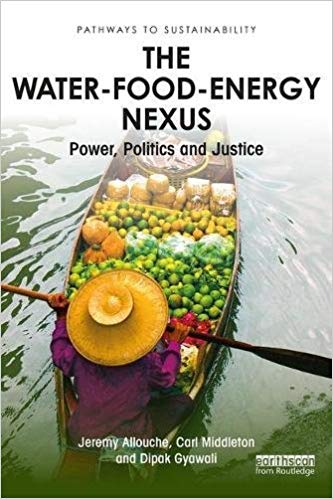Authors: Jeremy Allouche, Carl Middleton, and Dipak Gyawali

Framing the Water-Energy-Food Nexus in a new light
By Micheal Jacobson, Penn State
The authors advocate for transdisciplinary thinking which is more ‘reflexive and integrative’ than interdisciplinary approaches and seeks ‘broad participation incorporating knowledge from various sources and local knowledge in a holistic way that produces new knowledge.’ It is a bottom-up inclusive participatory approach that recognizes and promotes a greater diversity of interests, values, and strategies to broaden alternatives and solutions. Multiple voices, perspectives, perceived problems, and resulting solutions can be very different, depending on who’s at the table. Too often, local stakeholders are left out of the political process despite the fact they may have different but acceptable solutions – hence incorporation of environmental and social justice into the Nexus debate. A transdisciplinary approach can have hybrid solutions, aka, ‘many 10% solutions instead of one large solution.’ It is not simply about joining up and including all stakeholders in dialogue, but integrating local knowledge and value systems, and learning to discuss and accept other ways of thinking.
The book provides a historical perspective on the origins of the Nexus and shortfalls therein. Highlighted are past attempts by the water sector (who really drove and are still driving Nexus initiatives), such as the Integrated Water Resource Management (IWRM) approach. The book has a scattering of case studies from southeast Asia and Nepal to highlight some of the issues they raise. Additionally, it is neatly laid out in chapters with an introductory overview followed by a critique of the Nexus, followed by chapters discussing integration, knowledge building, transdisciplinary thinking, justice, and ethics. Finally, they conclude with what they call ‘democratizing the Nexus’ – to ensure that it is just not another ‘failed attempt at managing natural resources.’
The water-energy-food nexus (‘Nexus’) is a critical framework for addressing complex transdisciplinary resource challenges in integrated, innovative ways. Nexus thinking has received much attention in recent years, but what makes it different or novel in dealing with complex problems? And more importantly, does it work? Questions about the state of Nexus frameworks and approaches abound, such as 1) what is connected 2) how do these connections work and 3) what are the boundary issues? A new way of thinking about the Nexus is needed, say the authors of the recent book entitled “The Water-Food-Energy Nexus: Power, politics and Justice.”
Since the first Earth Day in 1970 and the ‘limits to growth’ driven environmental movement, scientists and policy makers have been concerned about complex global problems such as overpopulation, deforestation, climate change, food and energy security, and water scarcity. For example, it is well known that with rising population and incomes, by 2050 we will require 70% more food production globally, and up to 100% more in developing countries. Therefore, water withdrawals for irrigation will need to increase by at 10% over the same period. Compounding these problems are the risks and uncertainty from climate change and weather extremes. The Nexus integration framework evolved after the 2007/8 global food crisis, drawing on themes such as Anthropocene, ‘green economy’ and ‘planetary boundaries.’ ‘Climate smart agriculture’ and ‘sustainable intensification’ are recent approaches to deal with these pressing issues. Another compelling reason for integrating water, energy, and food systems is achieving the sustainable development goals (SDGs). Although presented as independent goals and evaluated independently, SDGs are more than the sum of the parts.
Given our desire for solutions to these global crises, the dominant discourse is using data, models, economic efficiency, and optimization tools to find tradeoffs, synergies, and solutions to these complex problems. Herein lies the authors’ main point, that there is no ‘one way to skin the cat’ and ‘stability and durability’ type technical and market solutions, as evidenced by top-down large-scale infrastructure projects such as dams and plantations, are not sustainable. They argue these ‘hard solutions’ can have unintended consequences. An example they provide is land and resource grabbing, often resulting in fewer benefits for small-scale farmers and fishers. Neglecting these stakeholders’ values and voices – who might be marginalized in these situations – leads to displacement and conflict.
The authors suggest viewing the Nexus as a political process rather than a technical activity. Building off theories of plural rationality (aka, cultural theories) and environmental and social justice literature, we can better understand these integrated systems. A dynamic framework of ‘resilience and robustness’ with plural approaches that are more inclusive and adaptive to address inherent power conflicts is proposed – hence the book’s subtitle. This is not simple. All stakeholders (representing different institutions, markets, and governance systems) in this process need to recognize that their perspective or entry point into Nexus discourse depends on whichever sector, and institution, they represent. People have vested interests and are not often willing to change their views to accommodate other ways of knowing.
The authors advocate for transdisciplinary thinking which is more ‘reflexive and integrative’ than interdisciplinary approaches and seeks ‘broad participation incorporating knowledge from various sources and local knowledge in a holistic way that produces new knowledge.’ It is a bottom-up inclusive participatory approach that recognizes and promotes a greater diversity of interests, values, and strategies to broaden alternatives and solutions. Multiple voices, perspectives, perceived problems, and resulting solutions can be very different, depending on who’s at the table. Too often, local stakeholders are left out of the political process despite the fact they may have different but acceptable solutions – hence incorporation of environmental and social justice into the Nexus debate. A transdisciplinary approach can have hybrid solutions, aka, ‘many 10% solutions instead of one large solution.’ It is not simply about joining up and including all stakeholders in dialogue, but integrating local knowledge and value systems, and learning to discuss and accept other ways of thinking.
The book provides a historical perspective on the origins of the Nexus and shortfalls therein. Highlighted are past attempts by the water sector (who really drove and are still driving Nexus initiatives), such as the Integrated Water Resource Management (IWRM) approach. The book has a scattering of case studies from southeast Asia and Nepal to highlight some of the issues they raise. Additionally, it is neatly laid out in chapters with an introductory overview followed by a critique of the Nexus, followed by chapters discussing integration, knowledge building, transdisciplinary thinking, justice, and ethics. Finally, they conclude with what they call ‘democratizing the Nexus’ – to ensure that it is just not another ‘failed attempt at managing natural resources.’
_________________________________________
1/ Allouche, J.; Middleton, C. and Gyawali, D. 2018. The Water-Food-Energy Nexus: Power, Politics and Justice. Earthscan, 150 p., ISBN: 978-0-415-33283-5
2/ FAO 2011. State of the World’s Land and Water Resources for Food and Agriculture (SOLAW) http://www.fao.org/3/i1688e/i1688e00.pdf
